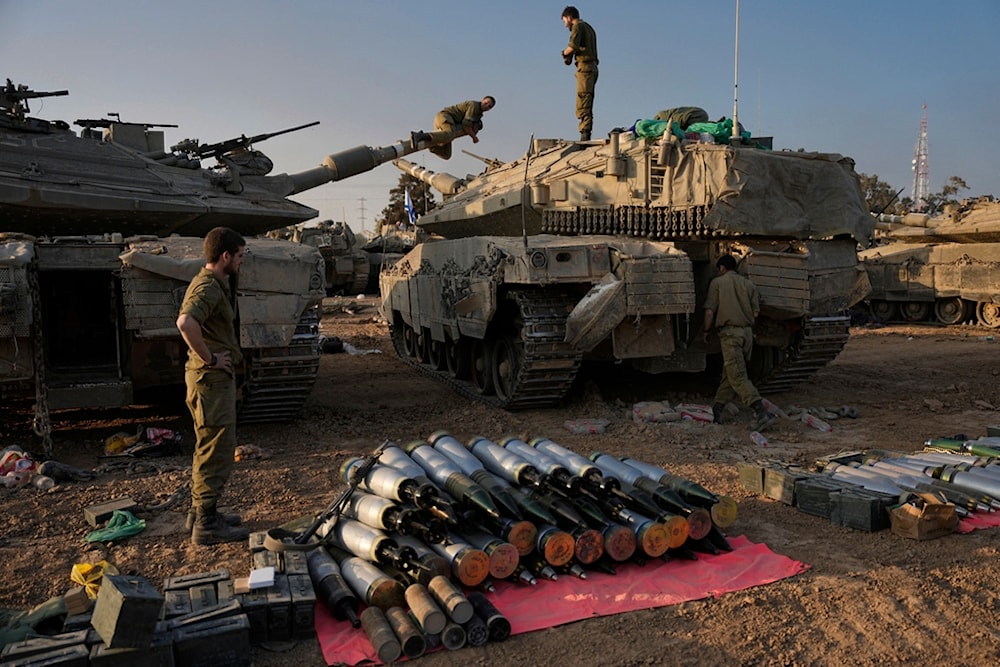Killing Palestinians costs 'Israel' $220Mln per day: WashPo
Analysts predict that if the war persists for an additional five to ten months, the potential cost to "Israel" could soar to $50 billion, equivalent to 10% of the regime's GDP.
-

Israeli soldiers load shells onto a tank at a staging area in southern Palestine near the border with Gaza on Sunday, Dec. 31, 2023 (AP)
An analysis by The Washington Post on Sunday revealed that the war on Gaza is imposing a staggering daily cost of $220 million on "Israel", totaling nearly $18 billion thus far.
According to the financial newspaper Calcalist, if the war persists for an additional five to ten months, the potential cost to "Israel" could soar to $50 billion, equivalent to 10% of the regime's GDP.
The report, citing economists, highlighted the significant toll the war on Gaza has taken on the Israeli economy, impacting sectors such as tourism, the tech industry, and the construction sector, which heavily relies on Palestinian labor.
While "Israel" is renowned for its tech industry, the enlistment of reservists into the Israeli Occupation Forces (IOF) has adversely affected the sector. Simultaneously, the suspension of work permits for Palestinians has further contributed to the negative impact on the construction industry.
Zvi Eckstein, a former deputy governor of the Bank of Israel and an economist at Reichman University, conducted an analysis with fellow experts. He revealed that the impact on the regime's budget, incorporating reduced tax revenue, amounted to $19 billion in the fourth quarter of 2023 and is anticipated to rise to $20 billion in the first quarter of 2024.
Read more: Israeli economy to shrink 2% as workforce is displaced, drafted
Better off now?
The costs of the war are measured by considering various factors, as explained by Ono Academic College professor Yaron Zelekha, a former economist at the regime's Ministry of Finance. This includes the direct expenses of conducting the war, and the substantial decrease in economic activity, resulting in a decline in revenue. Deficit spending during the war leads to borrowing costs, which continue to impact budgeting long after the cessation of the fighting.
Comparing the current aggression on Gaza with past wars, he said that economists highlight the resilience of the modern Israeli economy, with the regime experiencing various regional wars since 1967.
"In the second intifada, a significant part of the damage was caused by misguided economic management," he noted. "There was significant government overspending and a simultaneous tax increase."
"The main difference between then and today is that back then, the government debt reached 100 percent of GDP, not 60 percent as it is today. Our current situation is much better."
Michal Dan-Harel, the managing director of Manpower "Israel", the regime's largest employment agency, said that "Israel’s economy experienced a shock wave comparable to the peak of the covid-19 pandemic."
He added that "significant portions of the economy came to a shutdown for nearly two weeks. People were in shock. Each day revealed the magnitude of the crisis, and discussions about normalcy, such as work or earning a living, became almost illegitimate."
Read more: Report details Israeli economic 'losses' due to war on Gaza, West Bank
How relevant is US assistance?
Annually, the US provides "Israel" with $3.8 billion in military support, facilitating the sharing of defense technology to enhance "Israel's" strategic advantage over its enemies.
"Israel" is also a prime customer of weaponry as it purchases hundreds of millions of dollars worth of bombs, missiles, and shells from the US.
The White House is advocating for a supplemental funding bill, earmarking $14 billion in aid to "Israel" for early 2024.
However, progress on the bill has encountered obstacles in Congress, where debates between Republicans and Democrats over funding for the US border have led to a stall.
Itai Ater, an economist affiliated with "Tel Aviv" University and serving as a senior fellow at the Israel Democracy Institute, emphasized the significance of US funding, referring to it as "crucial," noting, "we are talking about approximately 50 billion shekels [$13.8 billion]."
"If the expenditure on the war reaches around 150 to 200 billion shekels, it would constitute a quarter of the war costs. This is a hugely significant sum and also provides the American government the option to exert diplomatic pressure on us, which is a good thing, considering our government," he said.
Do not be fooled by the numbers
Al Mayadeen analysts caution against interpreting the figures indicating a struggling Israeli economy as conclusive evidence. They argue that if the economy had genuinely suffered, the regime would have opted to cease the war.
It's crucial to understand that "Israel" operates as an offshoot of US hegemony, ensuring a continuous flow of resources for its political agenda.
Looking back historically, forced labor movements and ethnic cleansing in Palestine have consistently been components of an imperialist policy, with British and Hashemite involvement in the expulsion of Palestinians.
In 1948, British support facilitated the formation of Zionist settler gangs into an army that successfully won the first Arab-Israeli war.
The creation of "Israel" and the narrative of fulfilling godly designs contribute to fueling the Arab-Israeli wars and create conditions conducive to militarism, a significant domain for global capital accumulation.
The colonial practice of Zionism in Palestine must thus be understood as the catalyst for wars aimed at regional depopulation and the promotion of militaristic growth.
Read more: Israeli economy at risk as 'Israel' continues its war on Gaza

 5 Min Read
5 Min Read








